Case Study on Food and Beverage Management
VerifiedAdded on 2020/04/15
|21
|3434
|38
AI Summary
Contribute Materials
Your contribution can guide someone’s learning journey. Share your
documents today.

Running Head: FOOD AND BEVERAGE MANAGEMENT
Food and beverage management
Food and beverage management
Secure Best Marks with AI Grader
Need help grading? Try our AI Grader for instant feedback on your assignments.
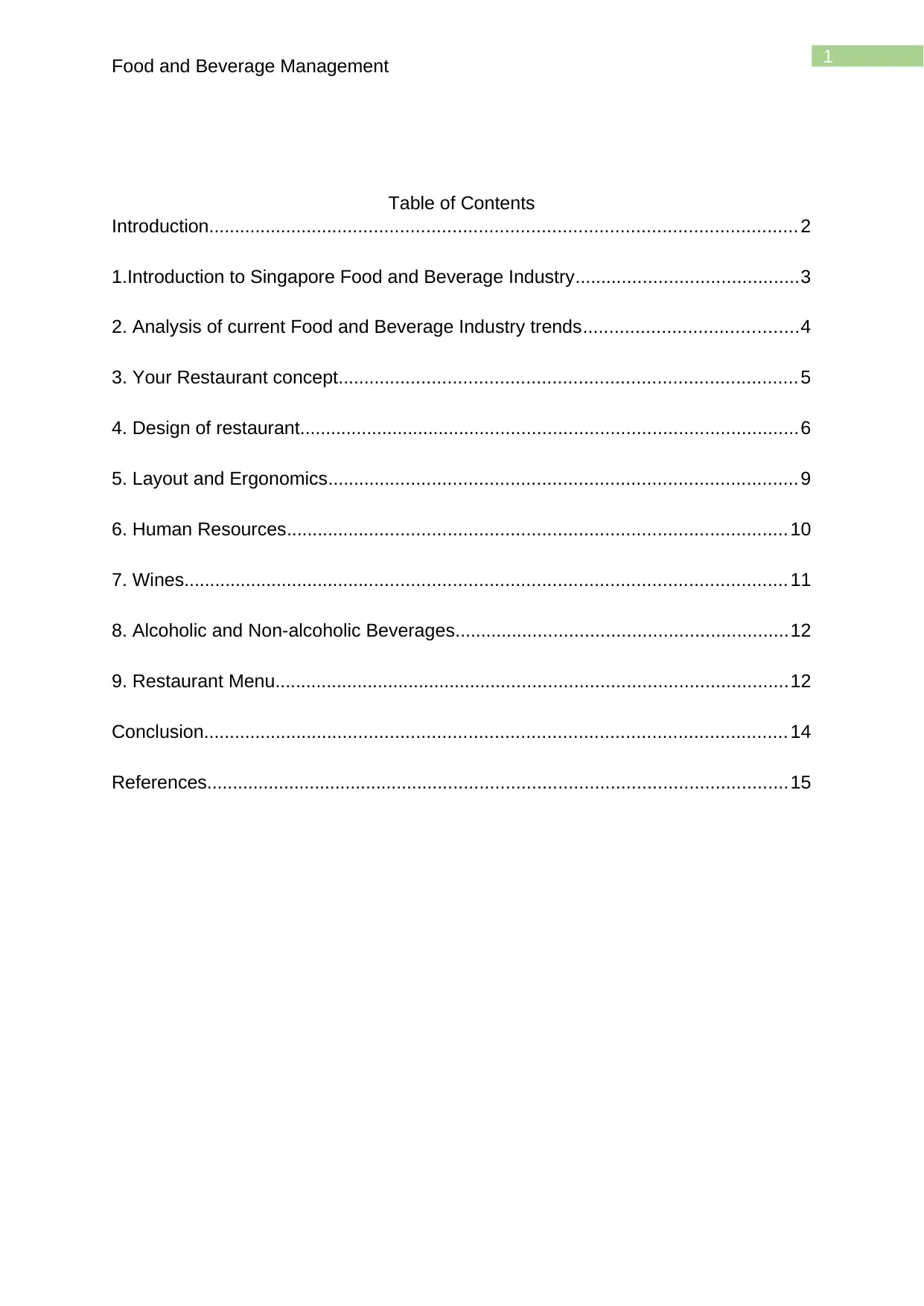
1
Food and Beverage Management
Table of Contents
Introduction................................................................................................................. 2
1.Introduction to Singapore Food and Beverage Industry...........................................3
2. Analysis of current Food and Beverage Industry trends.........................................4
3. Your Restaurant concept........................................................................................ 5
4. Design of restaurant................................................................................................6
5. Layout and Ergonomics..........................................................................................9
6. Human Resources................................................................................................ 10
7. Wines.................................................................................................................... 11
8. Alcoholic and Non-alcoholic Beverages................................................................12
9. Restaurant Menu...................................................................................................12
Conclusion................................................................................................................ 14
References................................................................................................................15
Food and Beverage Management
Table of Contents
Introduction................................................................................................................. 2
1.Introduction to Singapore Food and Beverage Industry...........................................3
2. Analysis of current Food and Beverage Industry trends.........................................4
3. Your Restaurant concept........................................................................................ 5
4. Design of restaurant................................................................................................6
5. Layout and Ergonomics..........................................................................................9
6. Human Resources................................................................................................ 10
7. Wines.................................................................................................................... 11
8. Alcoholic and Non-alcoholic Beverages................................................................12
9. Restaurant Menu...................................................................................................12
Conclusion................................................................................................................ 14
References................................................................................................................15

2
Food and Beverage Management
Introduction
With the development and swift changes in the field of technology and forces
of current trends in globalization, world has become a international village,
categorized by an explosive development in global business and competition.
Entrepreneurship that is one of the significant financial force for a country is
empowering people to search opportunity where others find Entrepreneurship, which
is one the most powerful financial force known to obstinate challenges. This study
will be based on setting up a restaurant business in the food and beverage industry
of Singapore. With all the specifications, a detail business plan will be set up for the
new restaurant business.
Food and Beverage Management
Introduction
With the development and swift changes in the field of technology and forces
of current trends in globalization, world has become a international village,
categorized by an explosive development in global business and competition.
Entrepreneurship that is one of the significant financial force for a country is
empowering people to search opportunity where others find Entrepreneurship, which
is one the most powerful financial force known to obstinate challenges. This study
will be based on setting up a restaurant business in the food and beverage industry
of Singapore. With all the specifications, a detail business plan will be set up for the
new restaurant business.
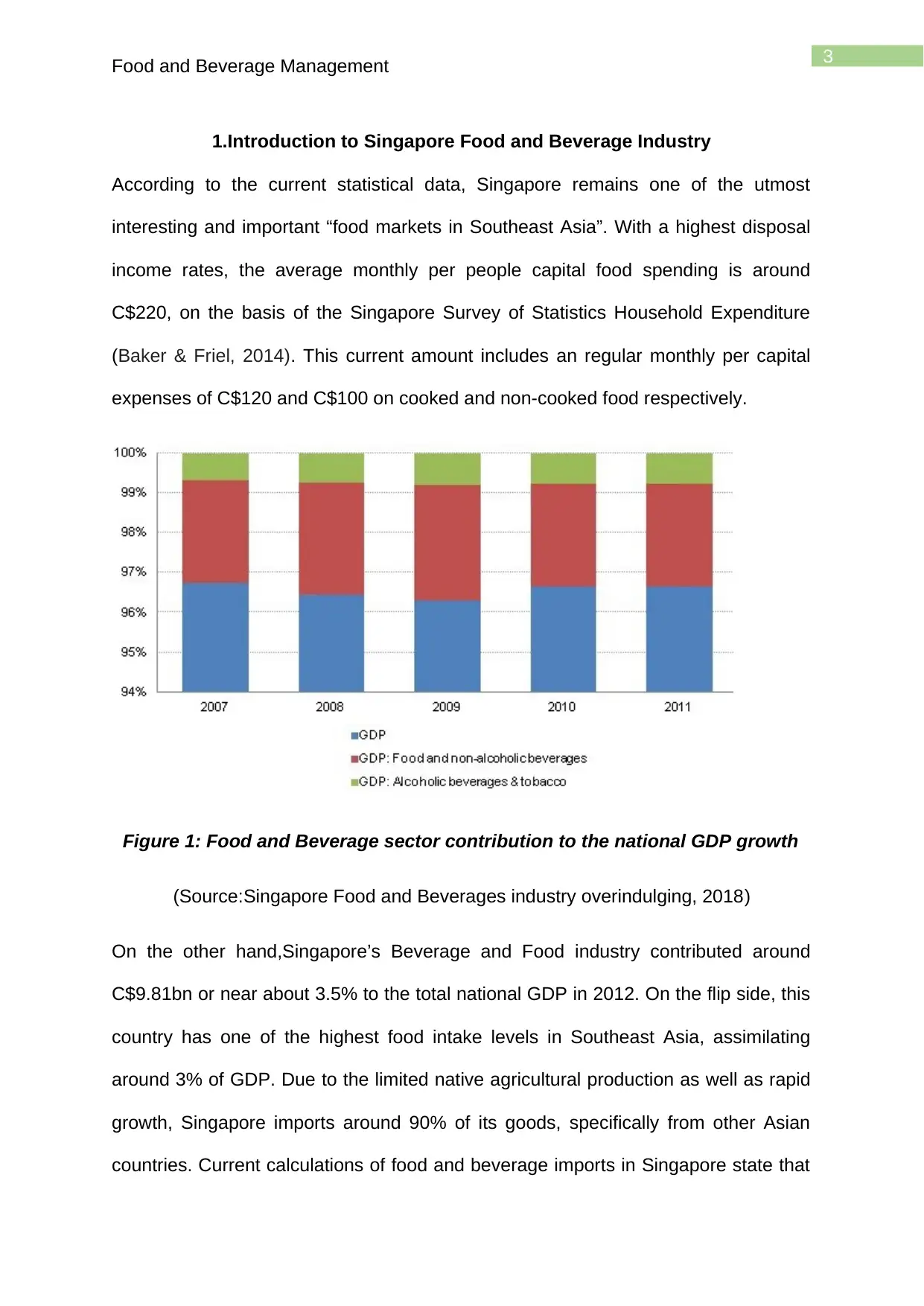
3
Food and Beverage Management
1.Introduction to Singapore Food and Beverage Industry
According to the current statistical data, Singapore remains one of the utmost
interesting and important “food markets in Southeast Asia”. With a highest disposal
income rates, the average monthly per people capital food spending is around
C$220, on the basis of the Singapore Survey of Statistics Household Expenditure
(Baker & Friel, 2014). This current amount includes an regular monthly per capital
expenses of C$120 and C$100 on cooked and non-cooked food respectively.
Figure 1: Food and Beverage sector contribution to the national GDP growth
(Source:Singapore Food and Beverages industry overindulging, 2018)
On the other hand,Singapore’s Beverage and Food industry contributed around
C$9.81bn or near about 3.5% to the total national GDP in 2012. On the flip side, this
country has one of the highest food intake levels in Southeast Asia, assimilating
around 3% of GDP. Due to the limited native agricultural production as well as rapid
growth, Singapore imports around 90% of its goods, specifically from other Asian
countries. Current calculations of food and beverage imports in Singapore state that
Food and Beverage Management
1.Introduction to Singapore Food and Beverage Industry
According to the current statistical data, Singapore remains one of the utmost
interesting and important “food markets in Southeast Asia”. With a highest disposal
income rates, the average monthly per people capital food spending is around
C$220, on the basis of the Singapore Survey of Statistics Household Expenditure
(Baker & Friel, 2014). This current amount includes an regular monthly per capital
expenses of C$120 and C$100 on cooked and non-cooked food respectively.
Figure 1: Food and Beverage sector contribution to the national GDP growth
(Source:Singapore Food and Beverages industry overindulging, 2018)
On the other hand,Singapore’s Beverage and Food industry contributed around
C$9.81bn or near about 3.5% to the total national GDP in 2012. On the flip side, this
country has one of the highest food intake levels in Southeast Asia, assimilating
around 3% of GDP. Due to the limited native agricultural production as well as rapid
growth, Singapore imports around 90% of its goods, specifically from other Asian
countries. Current calculations of food and beverage imports in Singapore state that
Secure Best Marks with AI Grader
Need help grading? Try our AI Grader for instant feedback on your assignments.
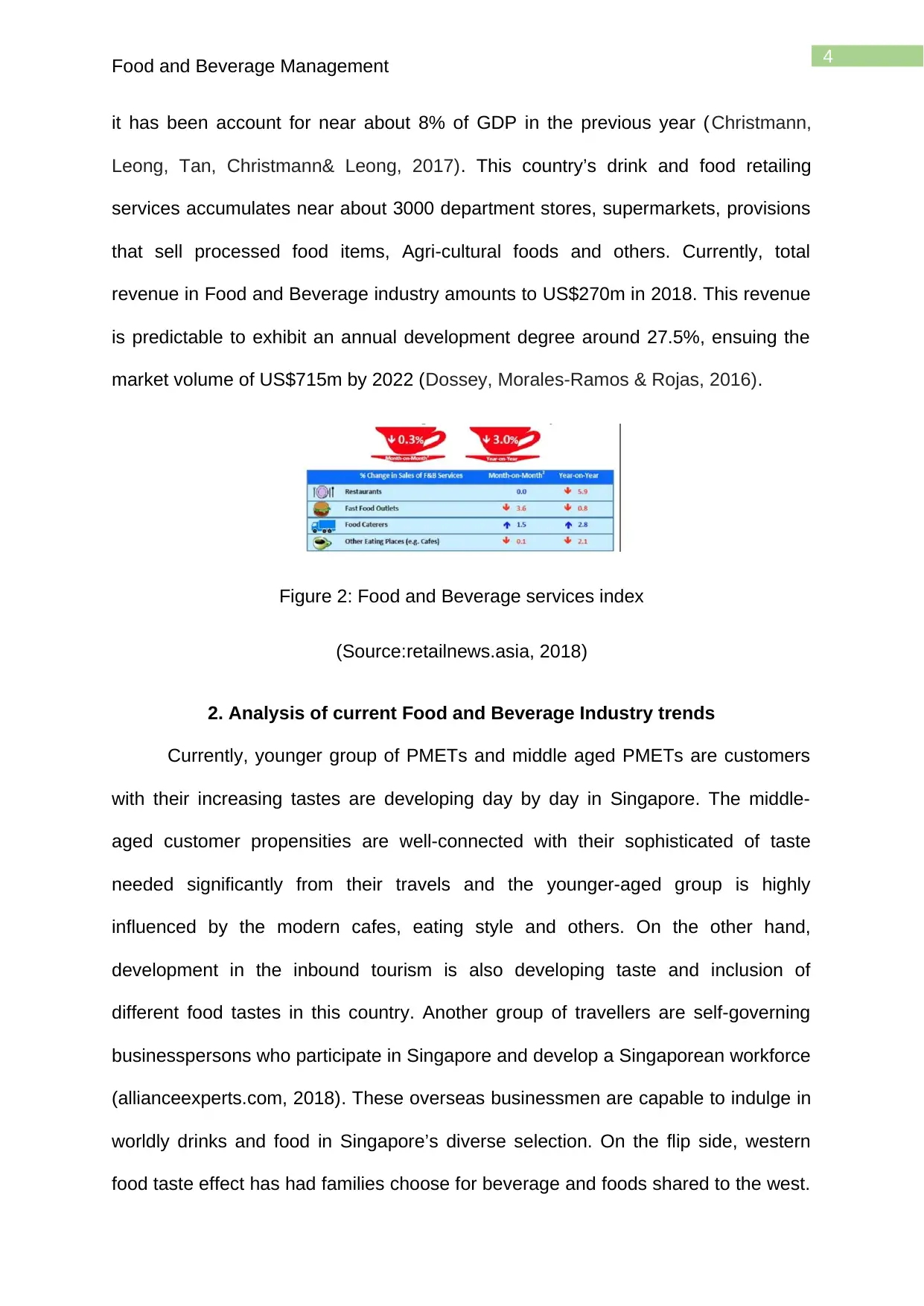
4
Food and Beverage Management
it has been account for near about 8% of GDP in the previous year ( Christmann,
Leong, Tan, Christmann& Leong, 2017). This country’s drink and food retailing
services accumulates near about 3000 department stores, supermarkets, provisions
that sell processed food items, Agri-cultural foods and others. Currently, total
revenue in Food and Beverage industry amounts to US$270m in 2018. This revenue
is predictable to exhibit an annual development degree around 27.5%, ensuing the
market volume of US$715m by 2022 (Dossey, Morales-Ramos & Rojas, 2016).
Figure 2: Food and Beverage services index
(Source:retailnews.asia, 2018)
2. Analysis of current Food and Beverage Industry trends
Currently, younger group of PMETs and middle aged PMETs are customers
with their increasing tastes are developing day by day in Singapore. The middle-
aged customer propensities are well-connected with their sophisticated of taste
needed significantly from their travels and the younger-aged group is highly
influenced by the modern cafes, eating style and others. On the other hand,
development in the inbound tourism is also developing taste and inclusion of
different food tastes in this country. Another group of travellers are self-governing
businesspersons who participate in Singapore and develop a Singaporean workforce
(allianceexperts.com, 2018). These overseas businessmen are capable to indulge in
worldly drinks and food in Singapore’s diverse selection. On the flip side, western
food taste effect has had families choose for beverage and foods shared to the west.
Food and Beverage Management
it has been account for near about 8% of GDP in the previous year ( Christmann,
Leong, Tan, Christmann& Leong, 2017). This country’s drink and food retailing
services accumulates near about 3000 department stores, supermarkets, provisions
that sell processed food items, Agri-cultural foods and others. Currently, total
revenue in Food and Beverage industry amounts to US$270m in 2018. This revenue
is predictable to exhibit an annual development degree around 27.5%, ensuing the
market volume of US$715m by 2022 (Dossey, Morales-Ramos & Rojas, 2016).
Figure 2: Food and Beverage services index
(Source:retailnews.asia, 2018)
2. Analysis of current Food and Beverage Industry trends
Currently, younger group of PMETs and middle aged PMETs are customers
with their increasing tastes are developing day by day in Singapore. The middle-
aged customer propensities are well-connected with their sophisticated of taste
needed significantly from their travels and the younger-aged group is highly
influenced by the modern cafes, eating style and others. On the other hand,
development in the inbound tourism is also developing taste and inclusion of
different food tastes in this country. Another group of travellers are self-governing
businesspersons who participate in Singapore and develop a Singaporean workforce
(allianceexperts.com, 2018). These overseas businessmen are capable to indulge in
worldly drinks and food in Singapore’s diverse selection. On the flip side, western
food taste effect has had families choose for beverage and foods shared to the west.
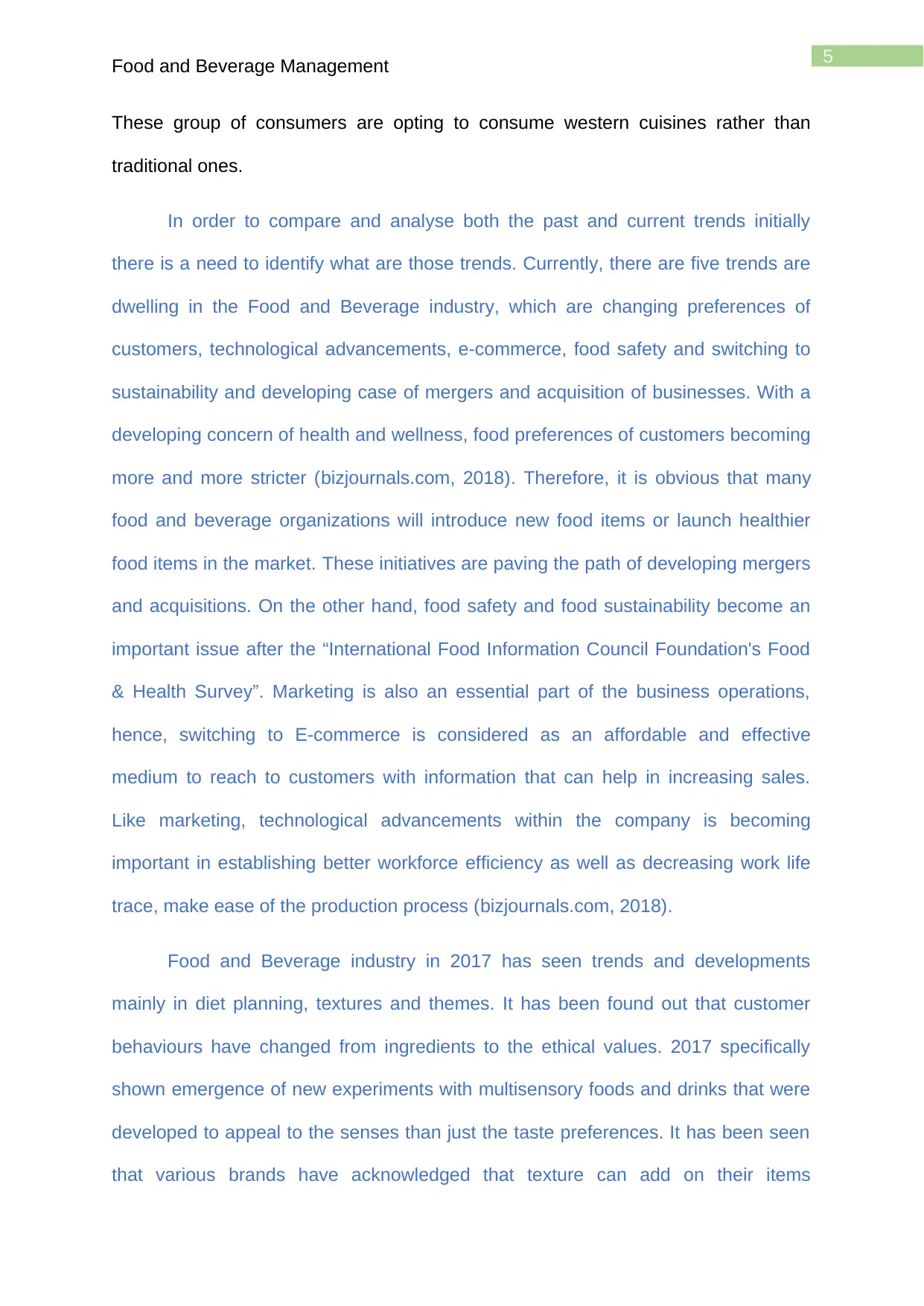
5
Food and Beverage Management
These group of consumers are opting to consume western cuisines rather than
traditional ones.
In order to compare and analyse both the past and current trends initially
there is a need to identify what are those trends. Currently, there are five trends are
dwelling in the Food and Beverage industry, which are changing preferences of
customers, technological advancements, e-commerce, food safety and switching to
sustainability and developing case of mergers and acquisition of businesses. With a
developing concern of health and wellness, food preferences of customers becoming
more and more stricter (bizjournals.com, 2018). Therefore, it is obvious that many
food and beverage organizations will introduce new food items or launch healthier
food items in the market. These initiatives are paving the path of developing mergers
and acquisitions. On the other hand, food safety and food sustainability become an
important issue after the “International Food Information Council Foundation's Food
& Health Survey”. Marketing is also an essential part of the business operations,
hence, switching to E-commerce is considered as an affordable and effective
medium to reach to customers with information that can help in increasing sales.
Like marketing, technological advancements within the company is becoming
important in establishing better workforce efficiency as well as decreasing work life
trace, make ease of the production process (bizjournals.com, 2018).
Food and Beverage industry in 2017 has seen trends and developments
mainly in diet planning, textures and themes. It has been found out that customer
behaviours have changed from ingredients to the ethical values. 2017 specifically
shown emergence of new experiments with multisensory foods and drinks that were
developed to appeal to the senses than just the taste preferences. It has been seen
that various brands have acknowledged that texture can add on their items
Food and Beverage Management
These group of consumers are opting to consume western cuisines rather than
traditional ones.
In order to compare and analyse both the past and current trends initially
there is a need to identify what are those trends. Currently, there are five trends are
dwelling in the Food and Beverage industry, which are changing preferences of
customers, technological advancements, e-commerce, food safety and switching to
sustainability and developing case of mergers and acquisition of businesses. With a
developing concern of health and wellness, food preferences of customers becoming
more and more stricter (bizjournals.com, 2018). Therefore, it is obvious that many
food and beverage organizations will introduce new food items or launch healthier
food items in the market. These initiatives are paving the path of developing mergers
and acquisitions. On the other hand, food safety and food sustainability become an
important issue after the “International Food Information Council Foundation's Food
& Health Survey”. Marketing is also an essential part of the business operations,
hence, switching to E-commerce is considered as an affordable and effective
medium to reach to customers with information that can help in increasing sales.
Like marketing, technological advancements within the company is becoming
important in establishing better workforce efficiency as well as decreasing work life
trace, make ease of the production process (bizjournals.com, 2018).
Food and Beverage industry in 2017 has seen trends and developments
mainly in diet planning, textures and themes. It has been found out that customer
behaviours have changed from ingredients to the ethical values. 2017 specifically
shown emergence of new experiments with multisensory foods and drinks that were
developed to appeal to the senses than just the taste preferences. It has been seen
that various brands have acknowledged that texture can add on their items
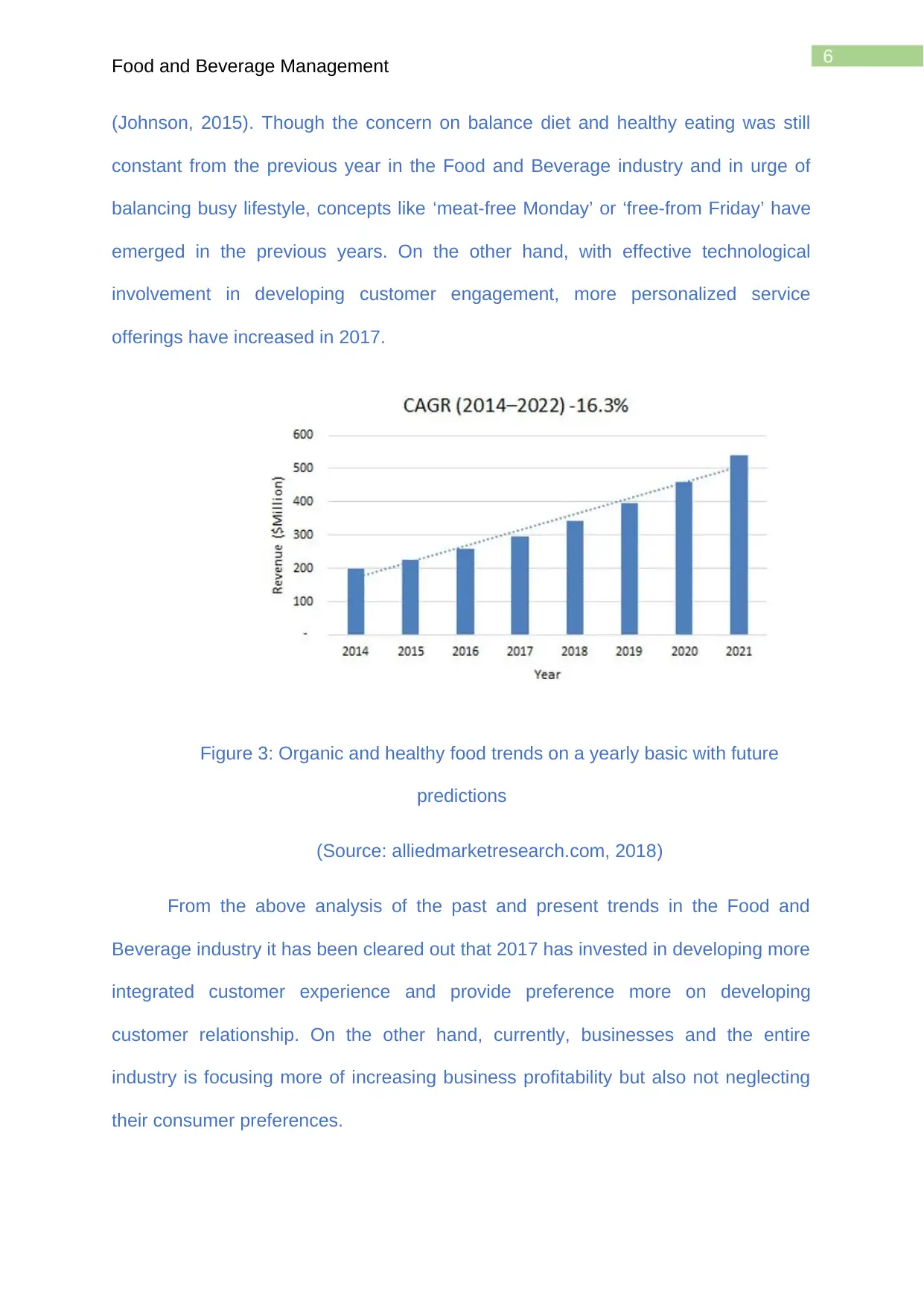
6
Food and Beverage Management
(Johnson, 2015). Though the concern on balance diet and healthy eating was still
constant from the previous year in the Food and Beverage industry and in urge of
balancing busy lifestyle, concepts like ‘meat-free Monday’ or ‘free-from Friday’ have
emerged in the previous years. On the other hand, with effective technological
involvement in developing customer engagement, more personalized service
offerings have increased in 2017.
Figure 3: Organic and healthy food trends on a yearly basic with future
predictions
(Source: alliedmarketresearch.com, 2018)
From the above analysis of the past and present trends in the Food and
Beverage industry it has been cleared out that 2017 has invested in developing more
integrated customer experience and provide preference more on developing
customer relationship. On the other hand, currently, businesses and the entire
industry is focusing more of increasing business profitability but also not neglecting
their consumer preferences.
Food and Beverage Management
(Johnson, 2015). Though the concern on balance diet and healthy eating was still
constant from the previous year in the Food and Beverage industry and in urge of
balancing busy lifestyle, concepts like ‘meat-free Monday’ or ‘free-from Friday’ have
emerged in the previous years. On the other hand, with effective technological
involvement in developing customer engagement, more personalized service
offerings have increased in 2017.
Figure 3: Organic and healthy food trends on a yearly basic with future
predictions
(Source: alliedmarketresearch.com, 2018)
From the above analysis of the past and present trends in the Food and
Beverage industry it has been cleared out that 2017 has invested in developing more
integrated customer experience and provide preference more on developing
customer relationship. On the other hand, currently, businesses and the entire
industry is focusing more of increasing business profitability but also not neglecting
their consumer preferences.
Paraphrase This Document
Need a fresh take? Get an instant paraphrase of this document with our AI Paraphraser
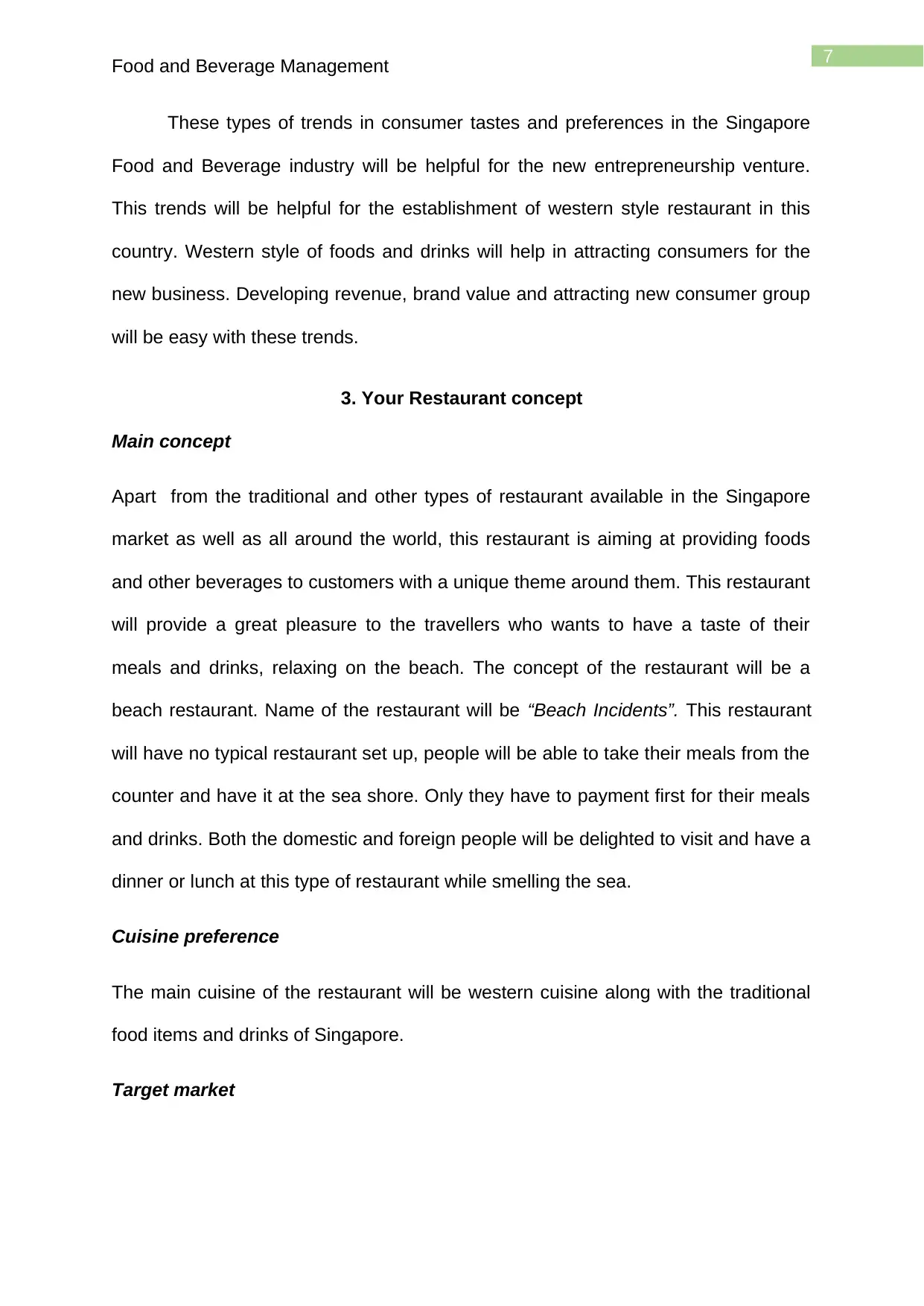
7
Food and Beverage Management
These types of trends in consumer tastes and preferences in the Singapore
Food and Beverage industry will be helpful for the new entrepreneurship venture.
This trends will be helpful for the establishment of western style restaurant in this
country. Western style of foods and drinks will help in attracting consumers for the
new business. Developing revenue, brand value and attracting new consumer group
will be easy with these trends.
3. Your Restaurant concept
Main concept
Apart from the traditional and other types of restaurant available in the Singapore
market as well as all around the world, this restaurant is aiming at providing foods
and other beverages to customers with a unique theme around them. This restaurant
will provide a great pleasure to the travellers who wants to have a taste of their
meals and drinks, relaxing on the beach. The concept of the restaurant will be a
beach restaurant. Name of the restaurant will be “Beach Incidents”. This restaurant
will have no typical restaurant set up, people will be able to take their meals from the
counter and have it at the sea shore. Only they have to payment first for their meals
and drinks. Both the domestic and foreign people will be delighted to visit and have a
dinner or lunch at this type of restaurant while smelling the sea.
Cuisine preference
The main cuisine of the restaurant will be western cuisine along with the traditional
food items and drinks of Singapore.
Target market
Food and Beverage Management
These types of trends in consumer tastes and preferences in the Singapore
Food and Beverage industry will be helpful for the new entrepreneurship venture.
This trends will be helpful for the establishment of western style restaurant in this
country. Western style of foods and drinks will help in attracting consumers for the
new business. Developing revenue, brand value and attracting new consumer group
will be easy with these trends.
3. Your Restaurant concept
Main concept
Apart from the traditional and other types of restaurant available in the Singapore
market as well as all around the world, this restaurant is aiming at providing foods
and other beverages to customers with a unique theme around them. This restaurant
will provide a great pleasure to the travellers who wants to have a taste of their
meals and drinks, relaxing on the beach. The concept of the restaurant will be a
beach restaurant. Name of the restaurant will be “Beach Incidents”. This restaurant
will have no typical restaurant set up, people will be able to take their meals from the
counter and have it at the sea shore. Only they have to payment first for their meals
and drinks. Both the domestic and foreign people will be delighted to visit and have a
dinner or lunch at this type of restaurant while smelling the sea.
Cuisine preference
The main cuisine of the restaurant will be western cuisine along with the traditional
food items and drinks of Singapore.
Target market
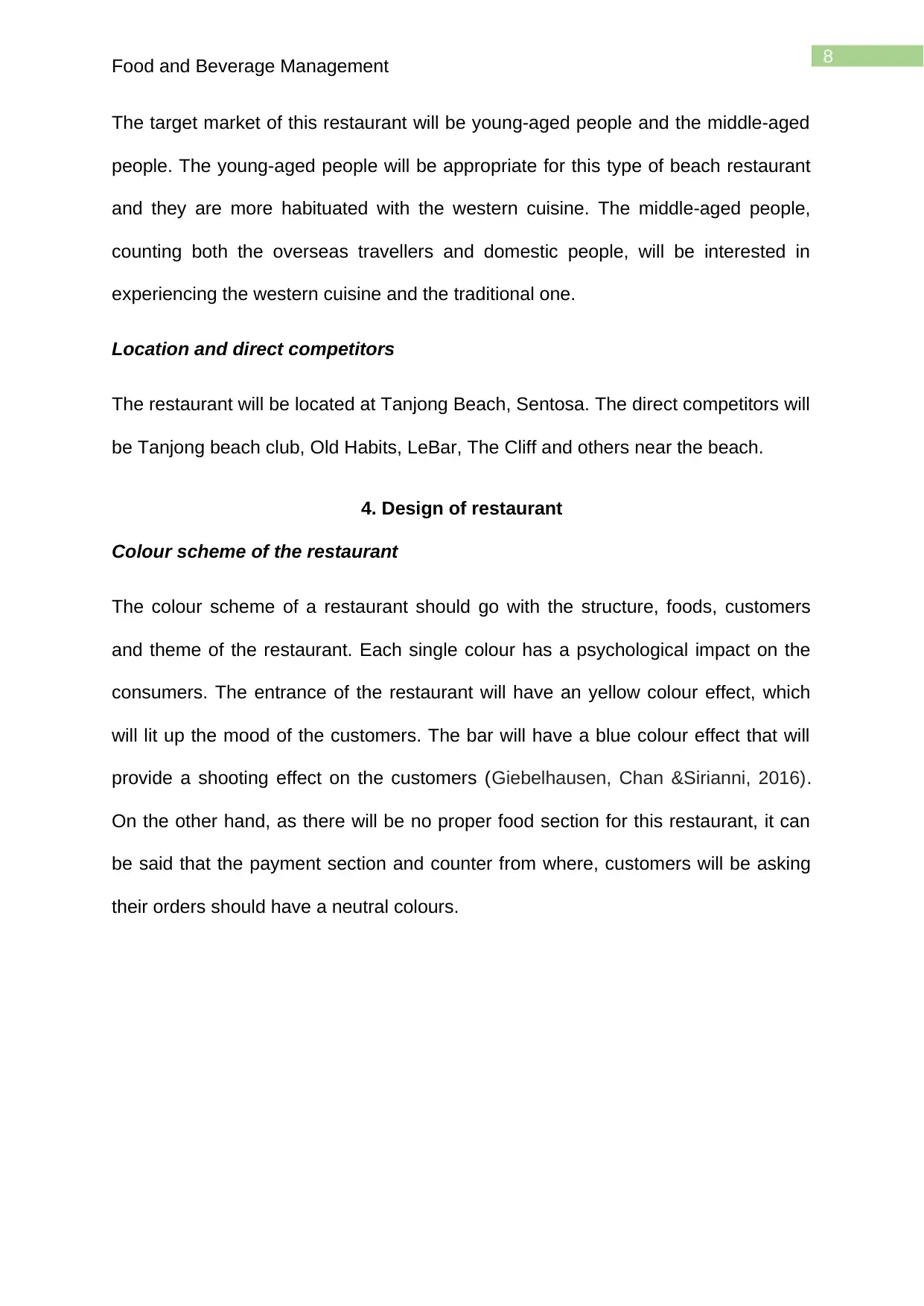
8
Food and Beverage Management
The target market of this restaurant will be young-aged people and the middle-aged
people. The young-aged people will be appropriate for this type of beach restaurant
and they are more habituated with the western cuisine. The middle-aged people,
counting both the overseas travellers and domestic people, will be interested in
experiencing the western cuisine and the traditional one.
Location and direct competitors
The restaurant will be located at Tanjong Beach, Sentosa. The direct competitors will
be Tanjong beach club, Old Habits, LeBar, The Cliff and others near the beach.
4. Design of restaurant
Colour scheme of the restaurant
The colour scheme of a restaurant should go with the structure, foods, customers
and theme of the restaurant. Each single colour has a psychological impact on the
consumers. The entrance of the restaurant will have an yellow colour effect, which
will lit up the mood of the customers. The bar will have a blue colour effect that will
provide a shooting effect on the customers (Giebelhausen, Chan &Sirianni, 2016).
On the other hand, as there will be no proper food section for this restaurant, it can
be said that the payment section and counter from where, customers will be asking
their orders should have a neutral colours.
Food and Beverage Management
The target market of this restaurant will be young-aged people and the middle-aged
people. The young-aged people will be appropriate for this type of beach restaurant
and they are more habituated with the western cuisine. The middle-aged people,
counting both the overseas travellers and domestic people, will be interested in
experiencing the western cuisine and the traditional one.
Location and direct competitors
The restaurant will be located at Tanjong Beach, Sentosa. The direct competitors will
be Tanjong beach club, Old Habits, LeBar, The Cliff and others near the beach.
4. Design of restaurant
Colour scheme of the restaurant
The colour scheme of a restaurant should go with the structure, foods, customers
and theme of the restaurant. Each single colour has a psychological impact on the
consumers. The entrance of the restaurant will have an yellow colour effect, which
will lit up the mood of the customers. The bar will have a blue colour effect that will
provide a shooting effect on the customers (Giebelhausen, Chan &Sirianni, 2016).
On the other hand, as there will be no proper food section for this restaurant, it can
be said that the payment section and counter from where, customers will be asking
their orders should have a neutral colours.
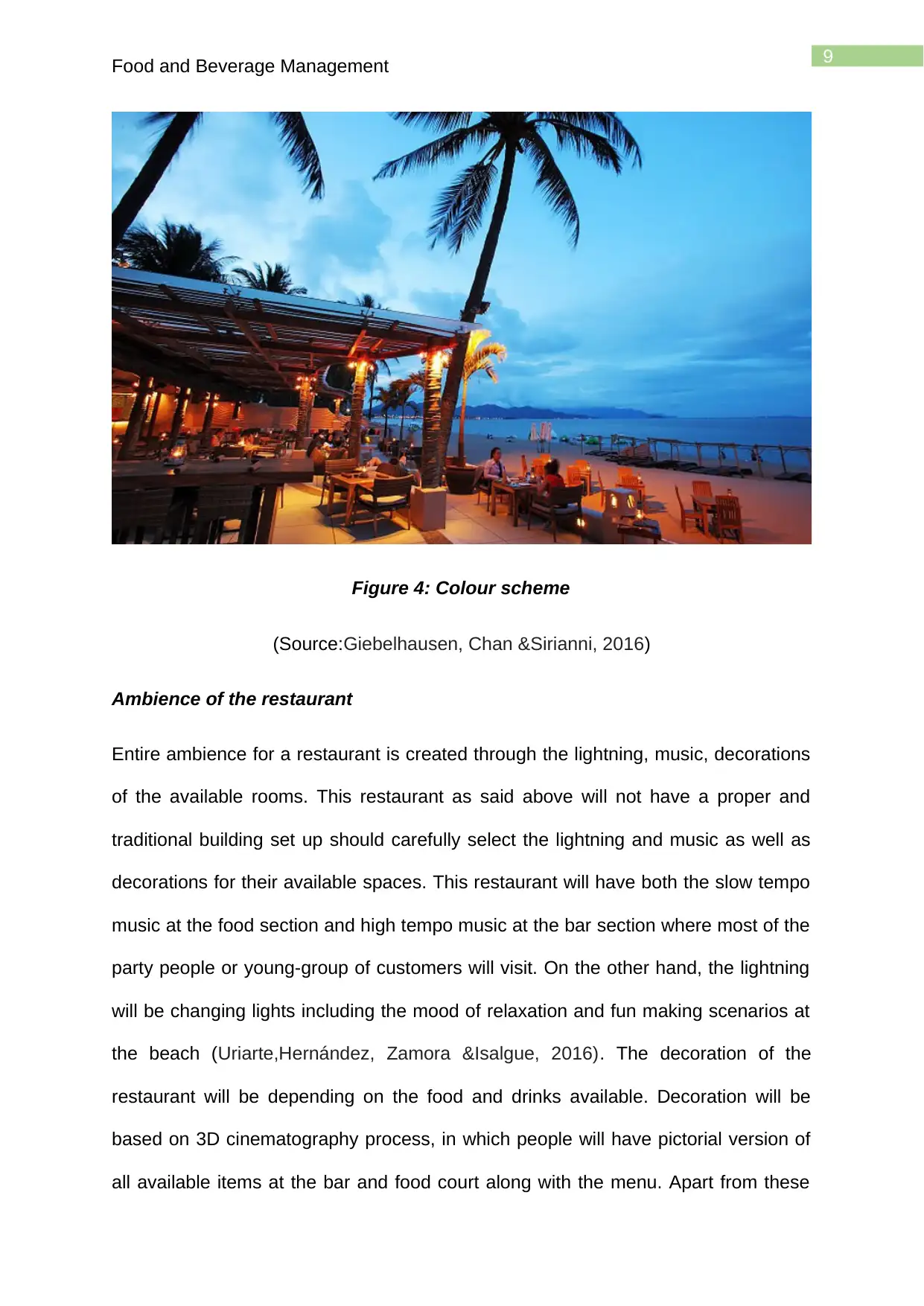
9
Food and Beverage Management
Figure 4: Colour scheme
(Source:Giebelhausen, Chan &Sirianni, 2016)
Ambience of the restaurant
Entire ambience for a restaurant is created through the lightning, music, decorations
of the available rooms. This restaurant as said above will not have a proper and
traditional building set up should carefully select the lightning and music as well as
decorations for their available spaces. This restaurant will have both the slow tempo
music at the food section and high tempo music at the bar section where most of the
party people or young-group of customers will visit. On the other hand, the lightning
will be changing lights including the mood of relaxation and fun making scenarios at
the beach (Uriarte,Hernández, Zamora &Isalgue, 2016). The decoration of the
restaurant will be depending on the food and drinks available. Decoration will be
based on 3D cinematography process, in which people will have pictorial version of
all available items at the bar and food court along with the menu. Apart from these
Food and Beverage Management
Figure 4: Colour scheme
(Source:Giebelhausen, Chan &Sirianni, 2016)
Ambience of the restaurant
Entire ambience for a restaurant is created through the lightning, music, decorations
of the available rooms. This restaurant as said above will not have a proper and
traditional building set up should carefully select the lightning and music as well as
decorations for their available spaces. This restaurant will have both the slow tempo
music at the food section and high tempo music at the bar section where most of the
party people or young-group of customers will visit. On the other hand, the lightning
will be changing lights including the mood of relaxation and fun making scenarios at
the beach (Uriarte,Hernández, Zamora &Isalgue, 2016). The decoration of the
restaurant will be depending on the food and drinks available. Decoration will be
based on 3D cinematography process, in which people will have pictorial version of
all available items at the bar and food court along with the menu. Apart from these
Secure Best Marks with AI Grader
Need help grading? Try our AI Grader for instant feedback on your assignments.

10
Food and Beverage Management
calligraphy and street arts will be there at the walls of the restaurant to encourage
young-customers.
Figure 5: Wall art at the restaurant
(Source: Kilmer & Kilmer, 2014)
Figure 6: Wall art at the entrance of the restaurant
(Source:Kilmer & Kilmer, 2014)
Food and Beverage Management
calligraphy and street arts will be there at the walls of the restaurant to encourage
young-customers.
Figure 5: Wall art at the restaurant
(Source: Kilmer & Kilmer, 2014)
Figure 6: Wall art at the entrance of the restaurant
(Source:Kilmer & Kilmer, 2014)

11
Food and Beverage Management
Figure 7: Sample of street arts at the restaurant walls
(Source: Kilmer & Kilmer, 2014)
5. Layout and Ergonomics
Maintaining effective layout and ergonomics at the restaurant is easy to reduce
chances of risk and stress from the staff as well as customers. The floor planning
and design of the restaurant is given below;
Figure 8: Floor plan for the restaurant
(Source: Nel,Williams, Steyn & Hind, 2018)
Food and Beverage Management
Figure 7: Sample of street arts at the restaurant walls
(Source: Kilmer & Kilmer, 2014)
5. Layout and Ergonomics
Maintaining effective layout and ergonomics at the restaurant is easy to reduce
chances of risk and stress from the staff as well as customers. The floor planning
and design of the restaurant is given below;
Figure 8: Floor plan for the restaurant
(Source: Nel,Williams, Steyn & Hind, 2018)
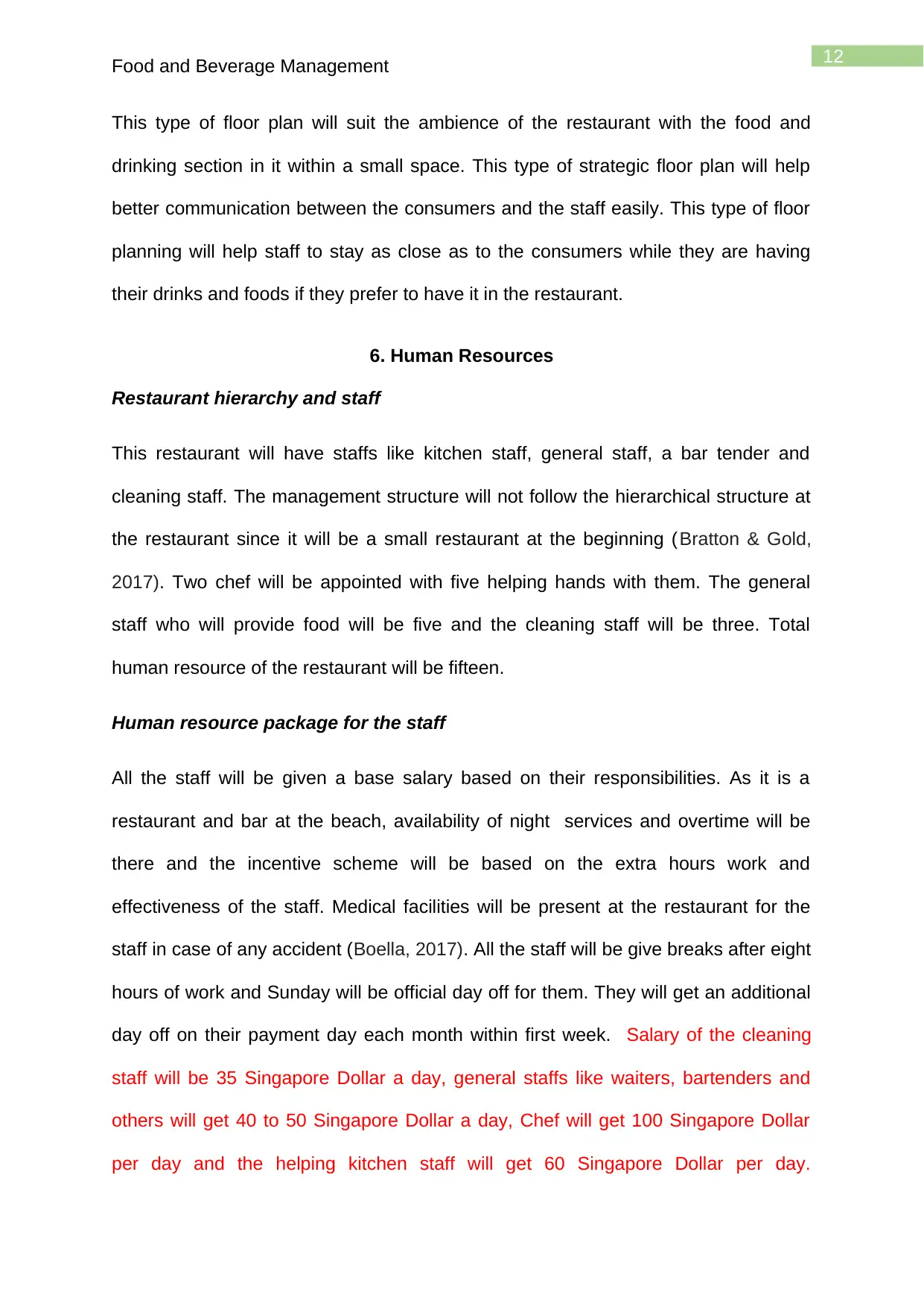
12
Food and Beverage Management
This type of floor plan will suit the ambience of the restaurant with the food and
drinking section in it within a small space. This type of strategic floor plan will help
better communication between the consumers and the staff easily. This type of floor
planning will help staff to stay as close as to the consumers while they are having
their drinks and foods if they prefer to have it in the restaurant.
6. Human Resources
Restaurant hierarchy and staff
This restaurant will have staffs like kitchen staff, general staff, a bar tender and
cleaning staff. The management structure will not follow the hierarchical structure at
the restaurant since it will be a small restaurant at the beginning (Bratton & Gold,
2017). Two chef will be appointed with five helping hands with them. The general
staff who will provide food will be five and the cleaning staff will be three. Total
human resource of the restaurant will be fifteen.
Human resource package for the staff
All the staff will be given a base salary based on their responsibilities. As it is a
restaurant and bar at the beach, availability of night services and overtime will be
there and the incentive scheme will be based on the extra hours work and
effectiveness of the staff. Medical facilities will be present at the restaurant for the
staff in case of any accident (Boella, 2017). All the staff will be give breaks after eight
hours of work and Sunday will be official day off for them. They will get an additional
day off on their payment day each month within first week. Salary of the cleaning
staff will be 35 Singapore Dollar a day, general staffs like waiters, bartenders and
others will get 40 to 50 Singapore Dollar a day, Chef will get 100 Singapore Dollar
per day and the helping kitchen staff will get 60 Singapore Dollar per day.
Food and Beverage Management
This type of floor plan will suit the ambience of the restaurant with the food and
drinking section in it within a small space. This type of strategic floor plan will help
better communication between the consumers and the staff easily. This type of floor
planning will help staff to stay as close as to the consumers while they are having
their drinks and foods if they prefer to have it in the restaurant.
6. Human Resources
Restaurant hierarchy and staff
This restaurant will have staffs like kitchen staff, general staff, a bar tender and
cleaning staff. The management structure will not follow the hierarchical structure at
the restaurant since it will be a small restaurant at the beginning (Bratton & Gold,
2017). Two chef will be appointed with five helping hands with them. The general
staff who will provide food will be five and the cleaning staff will be three. Total
human resource of the restaurant will be fifteen.
Human resource package for the staff
All the staff will be given a base salary based on their responsibilities. As it is a
restaurant and bar at the beach, availability of night services and overtime will be
there and the incentive scheme will be based on the extra hours work and
effectiveness of the staff. Medical facilities will be present at the restaurant for the
staff in case of any accident (Boella, 2017). All the staff will be give breaks after eight
hours of work and Sunday will be official day off for them. They will get an additional
day off on their payment day each month within first week. Salary of the cleaning
staff will be 35 Singapore Dollar a day, general staffs like waiters, bartenders and
others will get 40 to 50 Singapore Dollar a day, Chef will get 100 Singapore Dollar
per day and the helping kitchen staff will get 60 Singapore Dollar per day.
Paraphrase This Document
Need a fresh take? Get an instant paraphrase of this document with our AI Paraphraser
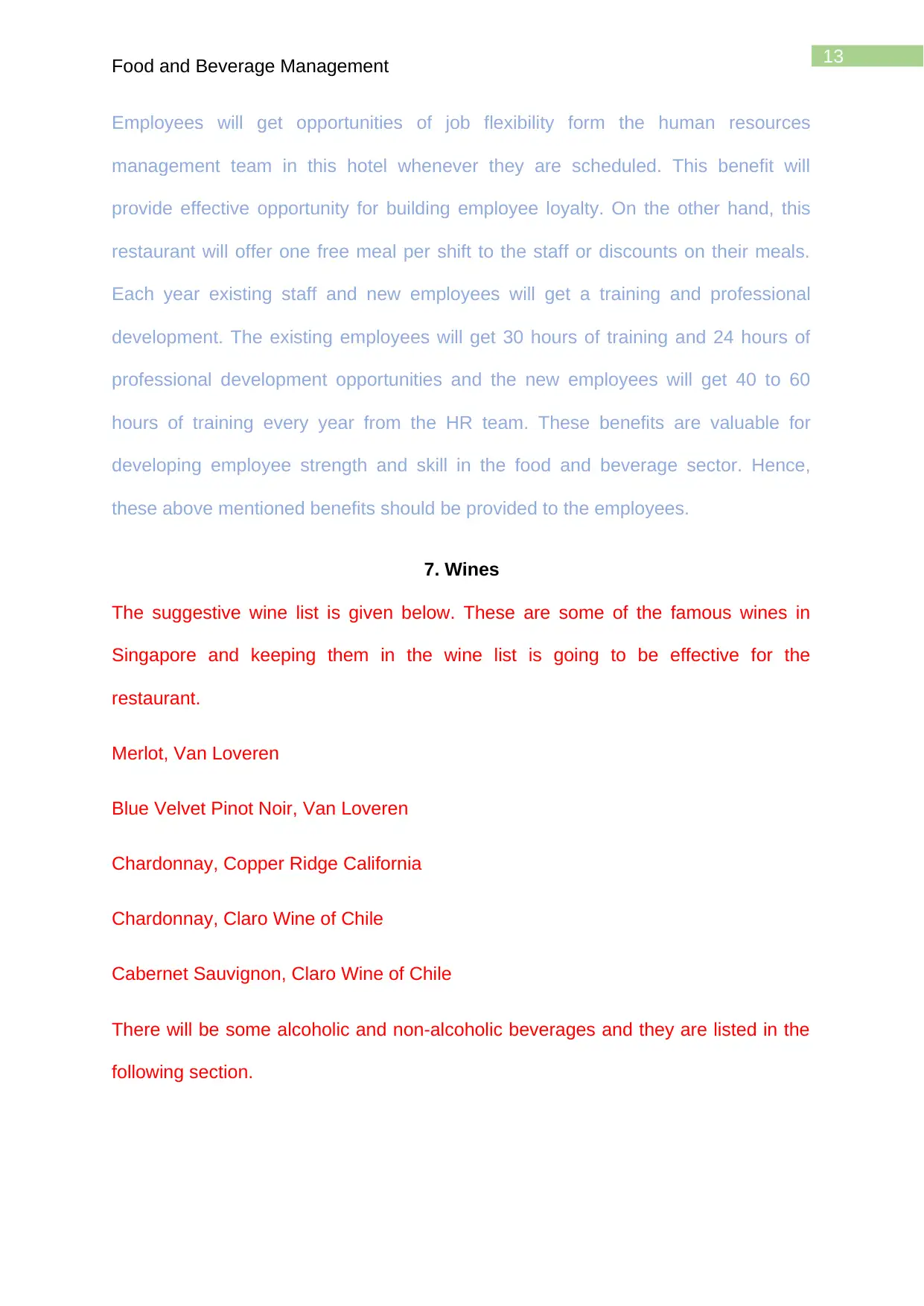
13
Food and Beverage Management
Employees will get opportunities of job flexibility form the human resources
management team in this hotel whenever they are scheduled. This benefit will
provide effective opportunity for building employee loyalty. On the other hand, this
restaurant will offer one free meal per shift to the staff or discounts on their meals.
Each year existing staff and new employees will get a training and professional
development. The existing employees will get 30 hours of training and 24 hours of
professional development opportunities and the new employees will get 40 to 60
hours of training every year from the HR team. These benefits are valuable for
developing employee strength and skill in the food and beverage sector. Hence,
these above mentioned benefits should be provided to the employees.
7. Wines
The suggestive wine list is given below. These are some of the famous wines in
Singapore and keeping them in the wine list is going to be effective for the
restaurant.
Merlot, Van Loveren
Blue Velvet Pinot Noir, Van Loveren
Chardonnay, Copper Ridge California
Chardonnay, Claro Wine of Chile
Cabernet Sauvignon, Claro Wine of Chile
There will be some alcoholic and non-alcoholic beverages and they are listed in the
following section.
Food and Beverage Management
Employees will get opportunities of job flexibility form the human resources
management team in this hotel whenever they are scheduled. This benefit will
provide effective opportunity for building employee loyalty. On the other hand, this
restaurant will offer one free meal per shift to the staff or discounts on their meals.
Each year existing staff and new employees will get a training and professional
development. The existing employees will get 30 hours of training and 24 hours of
professional development opportunities and the new employees will get 40 to 60
hours of training every year from the HR team. These benefits are valuable for
developing employee strength and skill in the food and beverage sector. Hence,
these above mentioned benefits should be provided to the employees.
7. Wines
The suggestive wine list is given below. These are some of the famous wines in
Singapore and keeping them in the wine list is going to be effective for the
restaurant.
Merlot, Van Loveren
Blue Velvet Pinot Noir, Van Loveren
Chardonnay, Copper Ridge California
Chardonnay, Claro Wine of Chile
Cabernet Sauvignon, Claro Wine of Chile
There will be some alcoholic and non-alcoholic beverages and they are listed in the
following section.

14
Food and Beverage Management
Food and Beverage Management
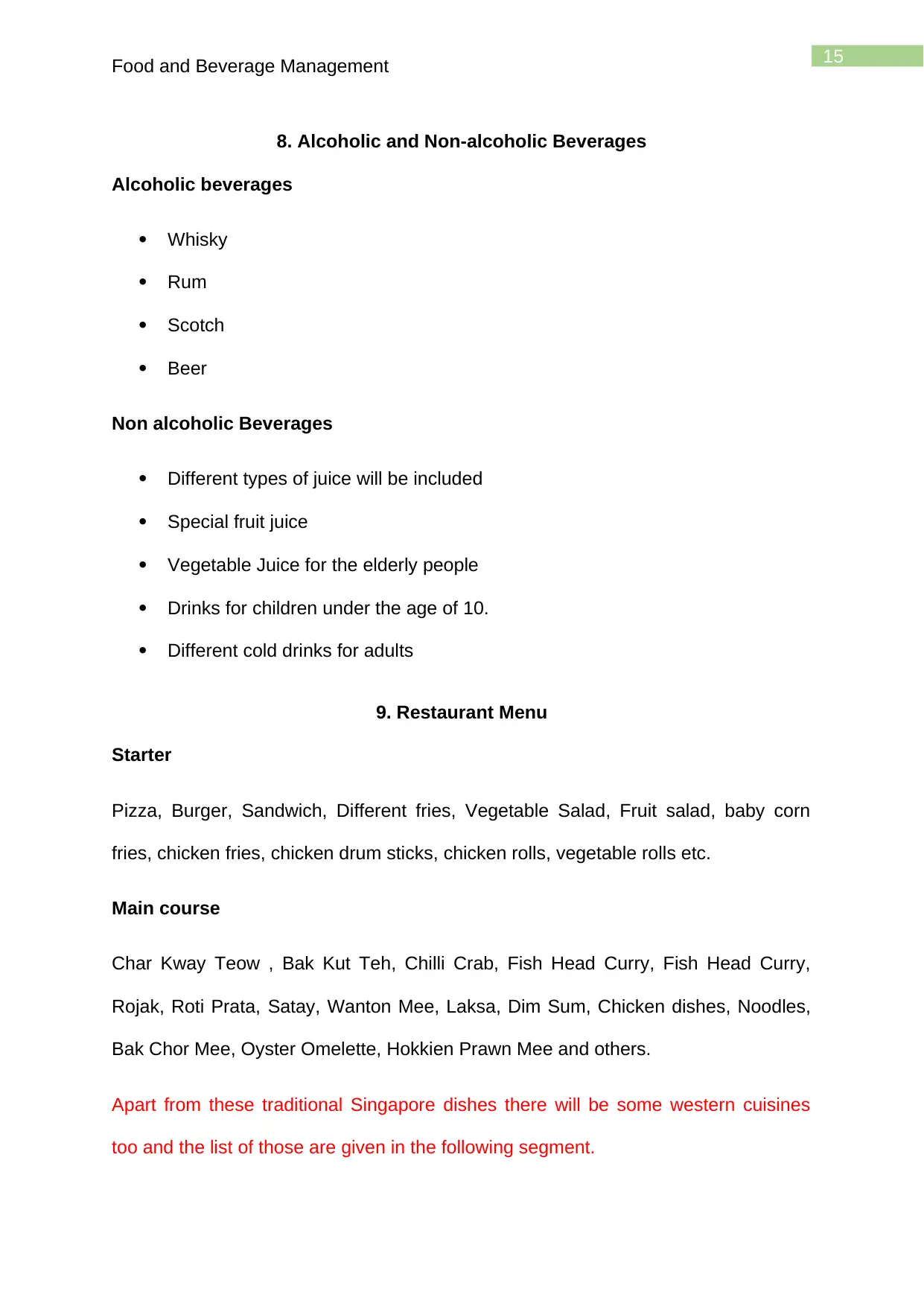
15
Food and Beverage Management
8. Alcoholic and Non-alcoholic Beverages
Alcoholic beverages
Whisky
Rum
Scotch
Beer
Non alcoholic Beverages
Different types of juice will be included
Special fruit juice
Vegetable Juice for the elderly people
Drinks for children under the age of 10.
Different cold drinks for adults
9. Restaurant Menu
Starter
Pizza, Burger, Sandwich, Different fries, Vegetable Salad, Fruit salad, baby corn
fries, chicken fries, chicken drum sticks, chicken rolls, vegetable rolls etc.
Main course
Char Kway Teow , Bak Kut Teh, Chilli Crab, Fish Head Curry, Fish Head Curry,
Rojak, Roti Prata, Satay, Wanton Mee, Laksa, Dim Sum, Chicken dishes, Noodles,
Bak Chor Mee, Oyster Omelette, Hokkien Prawn Mee and others.
Apart from these traditional Singapore dishes there will be some western cuisines
too and the list of those are given in the following segment.
Food and Beverage Management
8. Alcoholic and Non-alcoholic Beverages
Alcoholic beverages
Whisky
Rum
Scotch
Beer
Non alcoholic Beverages
Different types of juice will be included
Special fruit juice
Vegetable Juice for the elderly people
Drinks for children under the age of 10.
Different cold drinks for adults
9. Restaurant Menu
Starter
Pizza, Burger, Sandwich, Different fries, Vegetable Salad, Fruit salad, baby corn
fries, chicken fries, chicken drum sticks, chicken rolls, vegetable rolls etc.
Main course
Char Kway Teow , Bak Kut Teh, Chilli Crab, Fish Head Curry, Fish Head Curry,
Rojak, Roti Prata, Satay, Wanton Mee, Laksa, Dim Sum, Chicken dishes, Noodles,
Bak Chor Mee, Oyster Omelette, Hokkien Prawn Mee and others.
Apart from these traditional Singapore dishes there will be some western cuisines
too and the list of those are given in the following segment.
Secure Best Marks with AI Grader
Need help grading? Try our AI Grader for instant feedback on your assignments.

16
Food and Beverage Management
San Francisco sourdough bread, Pot roast, Fajitas, Chicken fried steak, Wild Alaska
salmon, California roll, Buffalo wings, Indian frybread and many others.
Food and Beverage Management
San Francisco sourdough bread, Pot roast, Fajitas, Chicken fried steak, Wild Alaska
salmon, California roll, Buffalo wings, Indian frybread and many others.
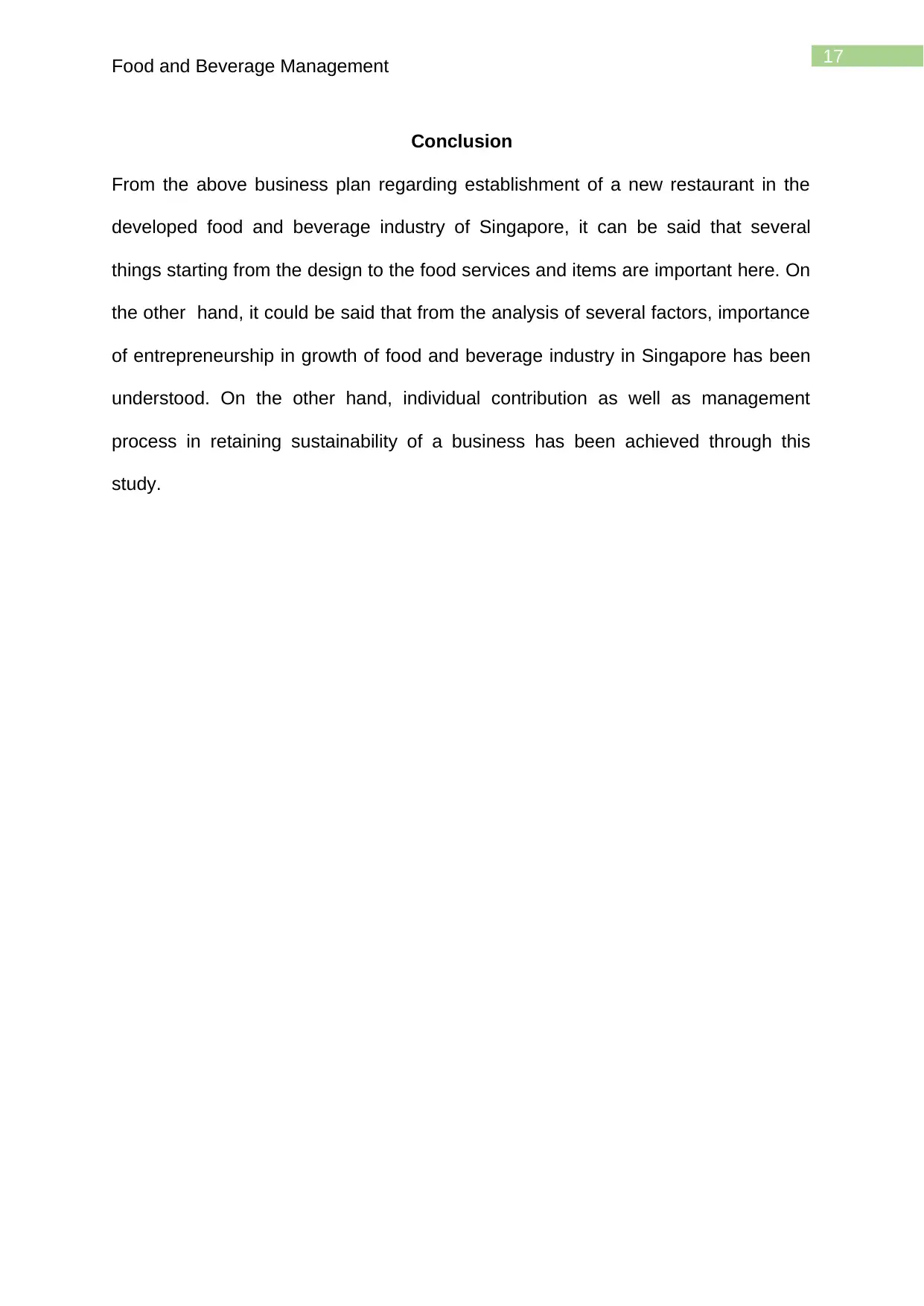
17
Food and Beverage Management
Conclusion
From the above business plan regarding establishment of a new restaurant in the
developed food and beverage industry of Singapore, it can be said that several
things starting from the design to the food services and items are important here. On
the other hand, it could be said that from the analysis of several factors, importance
of entrepreneurship in growth of food and beverage industry in Singapore has been
understood. On the other hand, individual contribution as well as management
process in retaining sustainability of a business has been achieved through this
study.
Food and Beverage Management
Conclusion
From the above business plan regarding establishment of a new restaurant in the
developed food and beverage industry of Singapore, it can be said that several
things starting from the design to the food services and items are important here. On
the other hand, it could be said that from the analysis of several factors, importance
of entrepreneurship in growth of food and beverage industry in Singapore has been
understood. On the other hand, individual contribution as well as management
process in retaining sustainability of a business has been achieved through this
study.

18
Food and Beverage Management
References
Baker, P., & Friel, S. (2014). Processed foods and the nutrition transition: evidence
from A sia. Obesity reviews, 15(7), 564-577.
Barth, J. J. (2017). Optimisation of Wine and Spirit Inventory Assets in Fine Dining
Restaurants. In Handbook of Research on Holistic Optimization Techniques
in the Hospitality, Tourism, and Travel Industry (pp. 365-380). IGI Global.
Bizjournals.com. (2018). Retrieved from
https://www.bizjournals.com/boston/news/2018/01/29/top-5-trends-for-food-
and-beverage-industry.html
Boella, M. (2017). Human resource management in the hotel and catering industry.
Routledge.
Bratton, J., & Gold, J. (2017). Human resource management: theory and practice.
Palgrave.
Christmann, P., Leong, J., Tan, M., Christmann, P., & Leong, J. (2017). EAC
Nutrition: Regional Expansion Strategy. Darden Business Publishing Cases,
1-25.
Dossey, A. T., Morales-Ramos, J. A., & Rojas, M. G. (Eds.). (2016). Insects as
sustainable food ingredients: production, processing and food applications.
Academic Press.
Food industry in Singapore and F&B Singapore market trends. (2018). Retrieved
from https://www.allianceexperts.com/en/knowledge/countries/asia/chances-
in-the-singapore-food-market/
Food and Beverage Management
References
Baker, P., & Friel, S. (2014). Processed foods and the nutrition transition: evidence
from A sia. Obesity reviews, 15(7), 564-577.
Barth, J. J. (2017). Optimisation of Wine and Spirit Inventory Assets in Fine Dining
Restaurants. In Handbook of Research on Holistic Optimization Techniques
in the Hospitality, Tourism, and Travel Industry (pp. 365-380). IGI Global.
Bizjournals.com. (2018). Retrieved from
https://www.bizjournals.com/boston/news/2018/01/29/top-5-trends-for-food-
and-beverage-industry.html
Boella, M. (2017). Human resource management in the hotel and catering industry.
Routledge.
Bratton, J., & Gold, J. (2017). Human resource management: theory and practice.
Palgrave.
Christmann, P., Leong, J., Tan, M., Christmann, P., & Leong, J. (2017). EAC
Nutrition: Regional Expansion Strategy. Darden Business Publishing Cases,
1-25.
Dossey, A. T., Morales-Ramos, J. A., & Rojas, M. G. (Eds.). (2016). Insects as
sustainable food ingredients: production, processing and food applications.
Academic Press.
Food industry in Singapore and F&B Singapore market trends. (2018). Retrieved
from https://www.allianceexperts.com/en/knowledge/countries/asia/chances-
in-the-singapore-food-market/
Paraphrase This Document
Need a fresh take? Get an instant paraphrase of this document with our AI Paraphraser

19
Food and Beverage Management
Giebelhausen, M. D., Chan, E., &Sirianni, N. J. (2016). Fitting Restaurant Service
Style to Brand Image for Greater Customer Satisfaction.
Gordon, R. T., &Brezinski, M. H. (2016). The complete restaurant management
guide. Routledge.
Johnson, D. (2015). Legislation and practices for texture-modified food for
institutional food. In Modifying Food Texture(pp. 223-238).
Kilmer, R., & Kilmer, W. O. (2014). Designing interiors. John Wiley & Sons.
Nel, J., Williams, A., Steyn, R., & Hind, C. (2018). Customer experiences and
expectations of sit-down restaurants: An auto-ethnographic perspective on
restaurant failure.
Organic Food and Beverages Market by Organic Foods (Organic Foods and
Vegetables, Organic Meat, Fish and Poultry, Organic Dairy Products, Organic
Frozen and Processed Foods, Other Organic Foods), and Organic Beverages
(Organic Non Dairy Beverages, Organic Coffee and Tea, Organic Beer and
Wine, and Other Organic Beverages) - Global Opportunity Analysis and
Industry Forecast, 2014-2022. (2018). Retrieved from
https://www.alliedmarketresearch.com/organic-food-beverage-market
Real Singapore retail sales stagnant. (2018). Retrieved from
https://www.retailnews.asia/real-singapore-retail-sales-stagnant/
Singapore Food and Beverages industry overindulging. (2018). Retrieved from
https://emergingmarketsdirect.wordpress.com/2012/05/22/singapore-food-
and-beverages-industry-overindulging/
Uriarte, U., Hernández, R. J., Zamora, J. L., &Isalgue, A. (2016). Side-view
atmospheres under outdoor midday high luminance. Buildings, 6(4), 53.
Food and Beverage Management
Giebelhausen, M. D., Chan, E., &Sirianni, N. J. (2016). Fitting Restaurant Service
Style to Brand Image for Greater Customer Satisfaction.
Gordon, R. T., &Brezinski, M. H. (2016). The complete restaurant management
guide. Routledge.
Johnson, D. (2015). Legislation and practices for texture-modified food for
institutional food. In Modifying Food Texture(pp. 223-238).
Kilmer, R., & Kilmer, W. O. (2014). Designing interiors. John Wiley & Sons.
Nel, J., Williams, A., Steyn, R., & Hind, C. (2018). Customer experiences and
expectations of sit-down restaurants: An auto-ethnographic perspective on
restaurant failure.
Organic Food and Beverages Market by Organic Foods (Organic Foods and
Vegetables, Organic Meat, Fish and Poultry, Organic Dairy Products, Organic
Frozen and Processed Foods, Other Organic Foods), and Organic Beverages
(Organic Non Dairy Beverages, Organic Coffee and Tea, Organic Beer and
Wine, and Other Organic Beverages) - Global Opportunity Analysis and
Industry Forecast, 2014-2022. (2018). Retrieved from
https://www.alliedmarketresearch.com/organic-food-beverage-market
Real Singapore retail sales stagnant. (2018). Retrieved from
https://www.retailnews.asia/real-singapore-retail-sales-stagnant/
Singapore Food and Beverages industry overindulging. (2018). Retrieved from
https://emergingmarketsdirect.wordpress.com/2012/05/22/singapore-food-
and-beverages-industry-overindulging/
Uriarte, U., Hernández, R. J., Zamora, J. L., &Isalgue, A. (2016). Side-view
atmospheres under outdoor midday high luminance. Buildings, 6(4), 53.
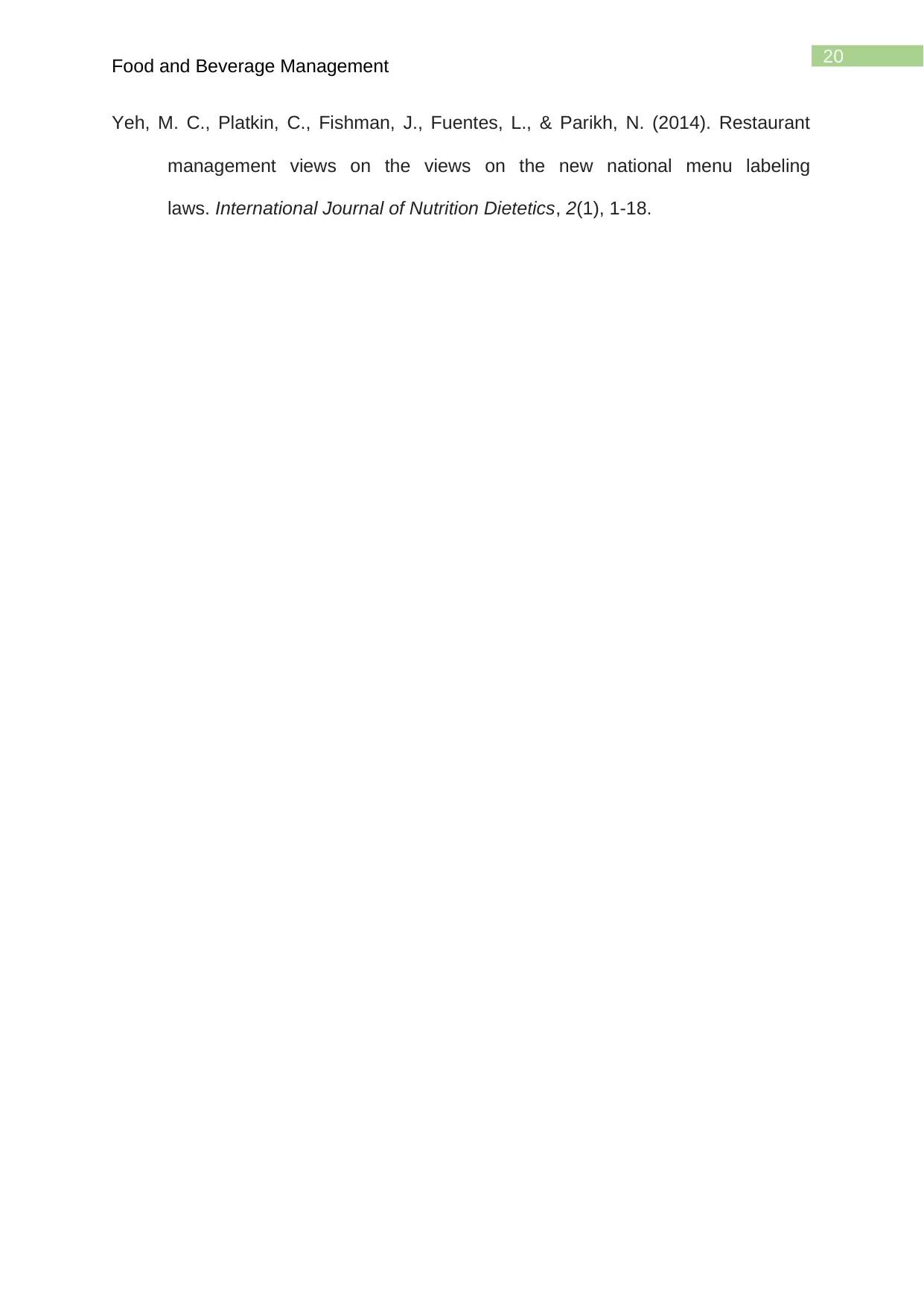
20
Food and Beverage Management
Yeh, M. C., Platkin, C., Fishman, J., Fuentes, L., & Parikh, N. (2014). Restaurant
management views on the views on the new national menu labeling
laws. International Journal of Nutrition Dietetics, 2(1), 1-18.
Food and Beverage Management
Yeh, M. C., Platkin, C., Fishman, J., Fuentes, L., & Parikh, N. (2014). Restaurant
management views on the views on the new national menu labeling
laws. International Journal of Nutrition Dietetics, 2(1), 1-18.
1 out of 21
Related Documents
Your All-in-One AI-Powered Toolkit for Academic Success.
+13062052269
info@desklib.com
Available 24*7 on WhatsApp / Email
![[object Object]](/_next/static/media/star-bottom.7253800d.svg)
Unlock your academic potential
© 2024 | Zucol Services PVT LTD | All rights reserved.
